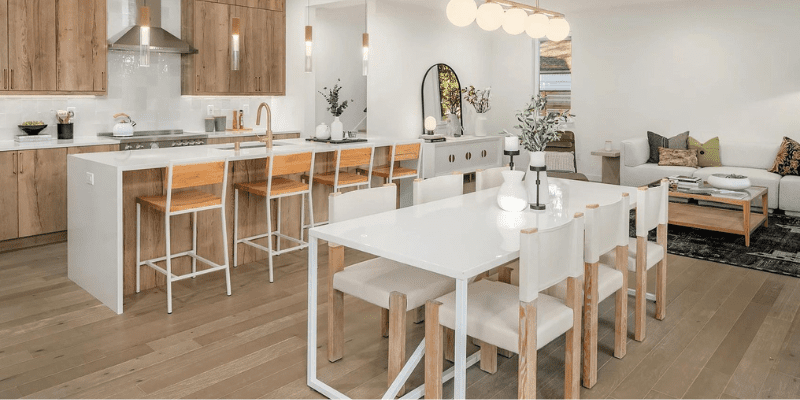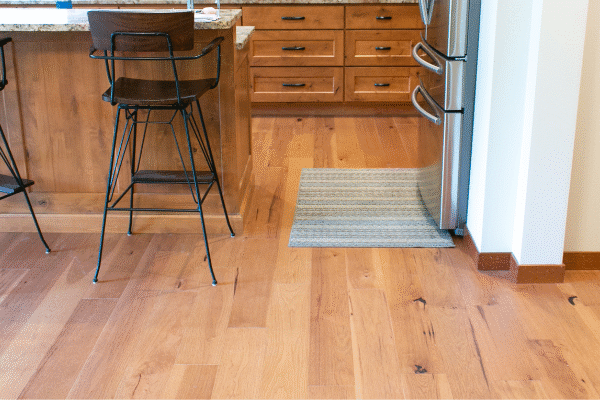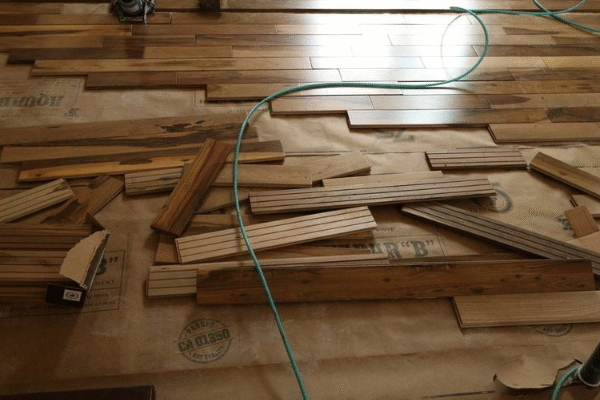What Is the Best Flooring for New Construction?
Your builder’s guide to choosing floors that look beautiful, perform in the Pacific Northwest climate, and deliver long‑term value in Seattle, Bellevue, Kirkland, Redmond, Woodinville, Issaquah, Sammamish, Mercer Island, and across Snohomish & King County.
The Foundation of Your Dream Home
When you’re building new, flooring is more than a finish—it’s a daily experience. It sets the tone for every room, affects comfort and acoustics, and influences resale value. With a blank canvas and coordinated construction schedule, you can select materials that work together across open plans, stairs, kitchens, and baths.
At LUKS Construction, we help homeowners match lifestyle and design with materials that perform in our damp winters and dry summers. Below is our practical guide to the best flooring for new construction—what to use, where to use it, and how to get professional results the first time.
Top Flooring Options—Strengths, Tradeoffs & Best Rooms
1) Solid Hardwood — Timeless Beauty You Can Refinish
Best for: Main living areas, dining rooms, hallways, and hardwood stairs where longevity and resale value matter.
- Why homeowners love it: Classic warmth, increases home value, can be sanded and refinished multiple times, endless stain and sheen options.
- Considerations: Sensitive to humidity swings—acclimation is a must; not ideal below grade or in wet rooms; needs a quality moisture barrier and craft-level installation.
Seattle tip: Specify kiln-dried stock and allow acclimation to site conditions. Pair with dustless sanding & water-based polyurethane for fast cure and low odor.
2) Engineered Hardwood — Real Wood, Extra Stability
Best for: Open plans, wider planks, homes with radiant heat, and waterfront/hillside builds with seasonal humidity swings.
- Pros: Real-wood wear layer; multi-ply core resists movement; suitable over radiant heat; excellent for wide planks.
- Tradeoffs: Refinishing depends on wear-layer thickness—aim for 3–4mm+ if you want a future sand & refinish.
- Design win: Run wide-plank white oak through great rooms for a calm, modern look.
3) Luxury Vinyl Plank (LVP) — Waterproof, Tough, Budget‑Smart
Best for: Basements, mudrooms, busy households with pets/kids, rental units, or ADUs.
- Pros: 100% waterproof, scratch-resistant, huge style range (wood/stone looks), softer/warmer than tile.
- Tradeoffs: Doesn’t boost resale like hardwood; can fade with strong UV; floating installs demand a flat subfloor.
- Where it shines: Kitchens, laundry, and daylight basements in Seattle and Bellevue.
4) Porcelain & Ceramic Tile — Durability Champion
Best for: Bathrooms, custom showers, laundry rooms, entries, and heated floors.
- Pros: Ultra-durable, waterproof, easy to sanitize, massive design range from marble to terrazzo to wood-look.
- Tradeoffs: Cold/hard underfoot without heat; demands precise layout and professional waterproofing in wet zones.
- Pro combo: Pair with radiant heat for spa‑warm floors on chilly mornings.
5) Carpet — Quiet, Cozy, and Cost‑Effective
Best for: Bedrooms, playrooms, media rooms, and upstairs halls to soften sound.
- Pros: Warm and soft, excellent sound absorption, budget-friendly, fast to install late in the build.
- Tradeoffs: Shorter life in traffic lanes; choose solution-dyed fibers for stain resistance or natural wool blends for eco benefits.
How to Choose: A Simple Framework That Works
- Lifestyle: Pets, kids, entertaining? Prioritize durability and cleanability.
- Design vision: Consistency across an open plan often looks and lives better.
- Budget & value: Balance upfront costs with longevity and refinishing potential.
- Climate fit: Select materials and underlayments that handle the PNW’s moisture swings.
- Maintenance reality: Choose a finish that matches how you live, not just how you want to live.
Our Go‑To Floor Plans for New Homes
- “Forever Home” Plan: Engineered white oak (wide plank) in main areas; porcelain tile + heated floors in baths & mudroom; dense carpet in bedrooms; solid oak stair treads with durable water-based finish.
- “Busy Family” Plan: LVP in kitchen, mudroom, laundry, basement; engineered hardwood in living/dining/halls; carpet with premium pad in bedrooms; tile shower with niche & bench.
- “Rental & ADU” Plan: Waterproof LVP throughout for durability and quick turnovers; porcelain bath tile; acoustic underlayment to keep neighbors happy.
Finish & Sheen: Small Choices, Big Impact
- Water-based polyurethane: Low odor, fast cure, non-yellowing clarity—ideal for the Pacific Northwest schedule and look.
- Sheen: Matte and satin hide wear better than semi-gloss in active households.
- Texture: Wire-brushed or light texture helps disguise micro-scratches while adding tactile interest.
Underlayment, Moisture & Subfloor—The Hidden Performance Layer
- Flatness first: Floating LVP/laminate needs a very flat subfloor to avoid bounce, noise, and joint stress.
- Moisture control: Use proper vapor barriers over concrete and in basements to prevent cupping, mold, and odors.
- Sound & comfort: Quality underlayment reduces footfall noise and improves feel underfoot, especially in condos or multi-level homes.
Real Project Story: Bellevue New Build
A Bellevue family wanted a serene, cohesive main floor that could handle two big dogs and weekend hosting. We installed engineered white oak through the great room, kitchen, and hallways for visual flow; porcelain tile with radiant heat in the mudroom and all baths; and a dense, low‑pile carpet upstairs for quiet bedrooms. The result—warm, modern, easy to clean, and built to last.
Top 5 Tips from LUKS (Seattle Edition)
- Decide finishes early: Flooring thickness impacts stair math and cabinet/casing details.
- Acclimate the right way: Let wood equalize to jobsite conditions—rushing causes seasonal gaps.
- Mind transitions: Plan clean thresholds between tile and wood to avoid reducers in the middle of sightlines.
- Add heat where it matters: Powder rooms, primary baths, and basement entries feel premium with radiant warmth.
- Choose local pros: A team familiar with Seattle & the Eastside saves headaches and money.
Where LUKS Construction Excels
- Hardwood floor installation (solid & engineered) and dustless refinishing with water‑based polyurethane.
- Hardwood stairs build & refinishing for a statement entry.
- Tile flooring & walls, custom showers with proper waterproofing, and heated floors.
Serving Seattle, Bellevue, Kirkland, Redmond, Woodinville, Issaquah, Sammamish, Mercer Island, and all of Snohomish & King County, WA.
Ready to choose the perfect floors for your new build?
Book a free in‑home consultation with LUKS Construction. We’ll help you select materials, plan transitions, and finish on schedule—beautifully.
📞 425‑971‑2895 • 🌐 www.luksconstruction.com • ✉️ luksconstruction@gmail.com
FAQ: New Construction Flooring
Is engineered hardwood better than solid in Seattle?
For many new builds, yes. Engineered offers real‑wood beauty with added stability against seasonal humidity swings. Solid hardwood remains excellent when properly acclimated and installed.
Can I use one floor throughout?
Absolutely—engineered hardwood or LVP can run continuously for a seamless look. Use tile in wet zones and plan clean transitions.
What’s the best finish for families and pets?
Water‑based finish in a matte or satin sheen looks modern, cures fast, and hides everyday scuffs better than glossy finishes.
Keywords: hardwood floor installation Seattle, hardwood floor refinishing Seattle, flooring contractor Bellevue, dustless sanding Seattle, hardwood stairs refinishing Redmond, tile installation Kirkland, custom showers Bellevue, heated floors Issaquah, King County flooring.





